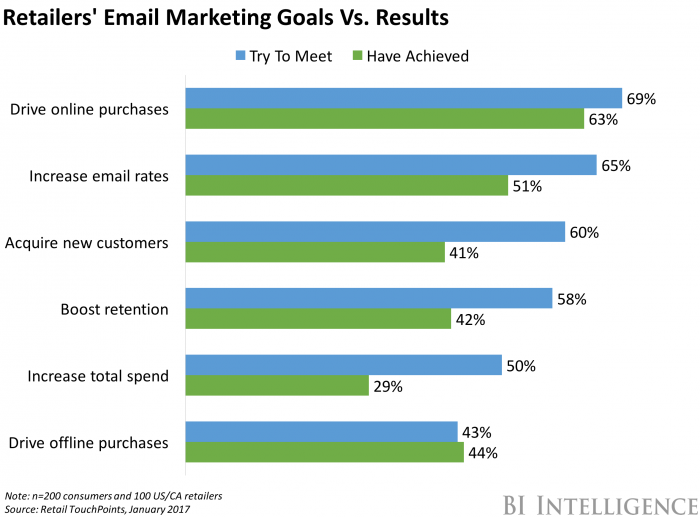Retailers miss on email marketing goals

BI Intelligence
This story was delivered to BI Intelligence "E-Commerce Briefing" subscribers. To learn more and subscribe, please click here.
While the majority of retailers believe that email is a critical investment for their business, many have yet to achieve their desired results using the communications channel, according to a recent survey from Retail TouchPoints of 200 consumers and 100 retailers.
When asked about email marketing objectives, 65% of retailers aimed to increase email rates — such as opens, click-through rates, and conversions — yet only 51% were able to successfully complete their objective.
Email is still a powerful tool for marketers in reaching consumers. Roughly 50% of respondents claimed that email was their preferred mode of receiving marketing material, according to a 2016 Adobe survey. Yet, more than one-third (37%) don’t open any emails from retailers, according to the Retail TouchPoints survey. Through effective personalized emails and increased investment of user behavior analytics, brands can potentially increase conversion rates and reach their full email marketing potential.
But marketers continue to miss the mark on these services. Underutilization of triggered emails, delivering relevant information, and sub-par data collection are key reasons that email marketing isn't quite hitting the mark.
Only 5% of consumers cite nearly all retail emails as relevant, timely and compelling, while one in four say they're rarely ever relevant.
Two-thirds of retailers capture purchase order history (68%) and website engagements (64%) from their customers.
And 17% of retailers don't utilize data at all to personalize marketing emails.
However, while retailers are falling short of their email marketing objectives, the survey highlights two encouraging findings for future success, mainly through more efficient use of advanced data analytics and the creation of enhanced personalized sends.
Personalized email sends, including the use of triggered emails. Nearly half of retailers (52%) plan to better personalize subject lines to drive opens or roll out triggered emails based on consumers’ online behavior (45%).
Advanced data analytics. Two-thirds of retailers plan to use data to boost engagement, sales, and customer retention over the next 12 to 24 months. It appears that companies are either doing this through increased internal investments or through acquisitions of data analytics firms — analytics is the most sought-after area of expansion this year among US executives, with 65% considering expanding or acquiring this type of business, according to a recent AdMedia Partners market report. Using data to improve the reach and triggering of email marketing could help drive up responses to these, ultimately lifting sales and benefiting the way businesses make use of this marketing channel.
Jessica Smith, research analyst at BI Intelligence, Business Insider’s premium research service, has compiled a detailed report on mobile marketing that takes a close look at the different tactics being used today, spanning legacy mobile technologies like SMS to emerging capabilities like beacon-aided location-based marketing. The report also identifies some of the most useful mobile marketing technologies that mobile marketers are putting to good use as parts of larger strategies.
Here are some key takeaways from the report:
As consumers spend more time on their mobile devices, marketing campaigns are following suit. Mobile ad spend continues to lag mobile time spent, providing an opportunity for creative marketers.
Marketers should leverage different mobile tactics depending on the size and demographics of the audience they want to reach and the type of message they want to send. With all tactics, marketers need to respect the personal nature of the mobile device and pay attention to the potential for communication overload.
Mobile messaging — particularly SMS and email — has the broadest reach and highest adoption among mobile users. Messaging apps, relative newcomers but gaining fast in popularity, offer more innovative and engaging outreach options.
Emerging technology, such as dynamic creative optimization, is breathing new life into mobile browser-based ad campaigns, but marketers should keep an eye on consumer adoption of mobile ad blockers.
In-app advertising can generate high engagement rates, especially with video. Location-based apps and beacons offer additional data that can enhance targeting capabilities.
In full, the report:
Identifies the major mobile technologies being used to reach consumers.
Sizes up the potential reach and potential of each of these mobile technologies.
Presents an example of a company or brand that has successfully leveraged that mobile technology to reach consumers.
Assesses the efficacy of each approach.
Examines the potential pitfalls and other shortcomings of each mobile technology.
To get your copy of this invaluable guide to the world of mobile marketing, choose one of these options:
Subscribe to an ALL-ACCESS Membership with BI Intelligence and gain immediate access to this report AND over 100 other expertly researched deep-dive reports, subscriptions to all of our daily newsletters, and much more. >> START A MEMBERSHIP
Purchase the report and download it immediately from our research store. >> BUY THE REPORT
The choice is yours. But however you decide to acquire this report, you’ve given yourself a powerful advantage in your understanding of how mobile marketing is rapidly evolving.
See Also:

 Yahoo News
Yahoo News 

